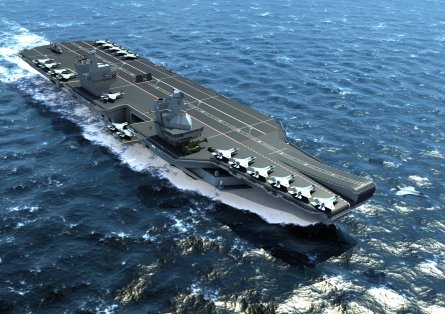UK manufacturers are entering the new year on a high of optimism, following release of the UK’s eagerly-anticipated Defence Industrial Strategy (DIS) white paper in mid-December. Described by its authors as an equivalent to the 1997 armed forces Strategic Defence Review, which ushered in the era of “smart procurement”, the new document outlines key business areas to be protected by the UK Ministry of Defence to ensure the sovereignty of its strategically important capabilities.

Detailing the document’s objectives on 15 December, defence secretary John Reid said: “A few years ago we spoke about getting smart on procurement – well, we haven’t always done that.” By using the new framework, the MoD will be able to ensure its armed forces receive battle-winning capabilities on time and to cost, he says, while also providing “outstanding clarity for industry for a healthy and sustainable future”. UK minister for defence procurement Lord Drayson puts it more simply – by providing the MoD’s equipment suppliers with a detailed overview of its equipment and spending plans until 2014, the DIS will mark an end to the “boom and bust” military spending of the past.
The white paper also continues an MoD trend to look at the UK’s defence companies less as equipment suppliers, but increasingly as systems integrators and partners to deliver through-life support and upgrades to a wide range of military systems. As the UK’s largest defence contractor, it is BAE Systems that will benefit the most from the newly outlined relationship. The outcome of the DIS can be viewed as a major victory for the company, which has for the past three years pushed hard to cement its relationship with the MoD to gain preferred supplier status.
This process sought to create “sensible terms of trade with the MoD”, moving away from potentially financially damaging fixed-price development and production deals, and to provide a strategy “spelling out the defence capabilities and resources that the MoD and government intend to maintain in the UK”, says company chief executive Mike Turner. “We now have the right framework and great confidence: I don’t think we’ve ever had such a positive outlook on air, sea and land,” he says. EADS UK chief executive Robin Southwell also welcomes the overall theme of the DIS, saying: “We hope that its contents will provide EADS with a foundation to further develop its UK business.”
In the days following the publication, the MoD underlined its partnership policy by announcing contracts with BAE and Rolls-Royce worth a combined £315 million ($550 million) to maintain, upgrade and support the Royal Air Force’s Panavia Tornado GR4 strike aircraft and their RB199 engines. In addition to providing stability for the suppliers, the multi-year agreements will also save over £230 million, according to the UK Defence Logistics Organisation. BAE, for one, hopes that such a model will be repeated in the future to also provide full support for the UK’s BAE Hawk 128, Nimrod MRA4, Eurofighter Typhoon and Lockheed Martin Joint Strike Fighter (JSF) aircraft.
This growing spirit of partnership is also evident on the UK’s two-ship future aircraft carrier (CVF) project, which has entered an up to one-year design and demonstration phase worth £300 million. Intended to further de-risk the project ahead of a production decision, this will be conducted by an industry alliance team already allocated 60% of the eventual build work on the 65,000t vessels. In a key development, BAE Systems, Babcock, Halliburton KBR, Thales and VT have all now signed a risk-sharing charter under which they will guarantee to meet programme time and cost objectives, which Reid says “will provide maximum leverage for the armed forces and the taxpayer”. The companies are also to come up with a transition plan to support operations of the Royal Navy’s current Invincible-class ships until the new platforms – previously estimated as costing up to £3.2 billion – enter service.
Highlighting the fact that “current plans do not envisage the UK needing to design and build a future generation of manned fast jet aircraft” beyond the Typhoon and JSF, the DIS prominently lists unmanned air vehicle technologies among those national capabilities to be developed and protected. BAE will in January 2006 receive funding to conduct an unmanned combat air vehicle technology demonstration programme for the MoD and has revealed that it has already conducted fully autonomous flights using an experimental stealthy design dubbed Corax.
The rotorcraft sector is another aviation area to benefit under the DIS. However, although AgustaWestland is likely to be the key beneficiary, Drayson notes: “We want sustained improvement” from the company. Lockheed Martin is meanwhile poised to receive an up to £800 million contract to upgrade the RN’s EH101 Merlin HM1s and EADS will during 2006 also step up its campaign to sell NH Industries’ NH90 transport helicopter to the UK armed forces. Sophisticated air-launched weapons and airborne intelligence, surveillance, target acquisition and reconnaissance systems are also of strategic importance, the review states.
The DIS seems to have ticked many boxes, with the MoD and leading manufacturers appearing largely satisfied with its recommendations. But the true test of the MoD’s new industrial vision will come only as the UK enters its next round of tough procurement decisions.
With a memorandum of understanding for the JSF programme’s production and sustainment phase to be signed by next December and the future of the CVF project to be decided around the same time, there is not long to wait.
CRAIG HOYLE/LONDON
Source: Flight International























